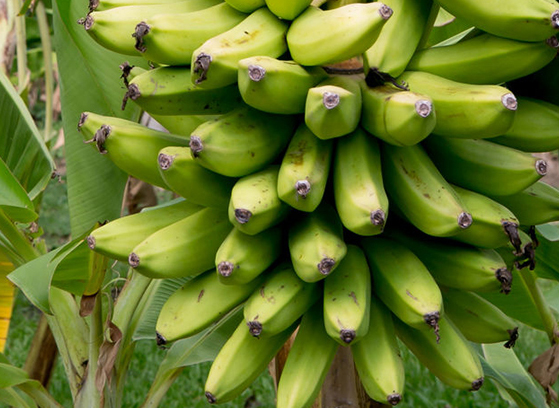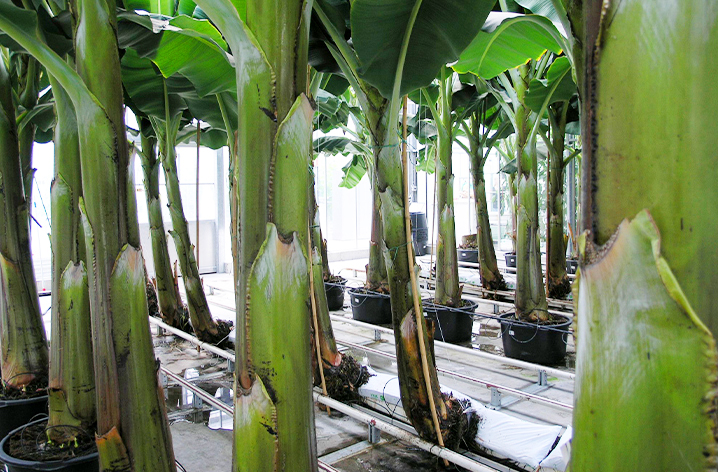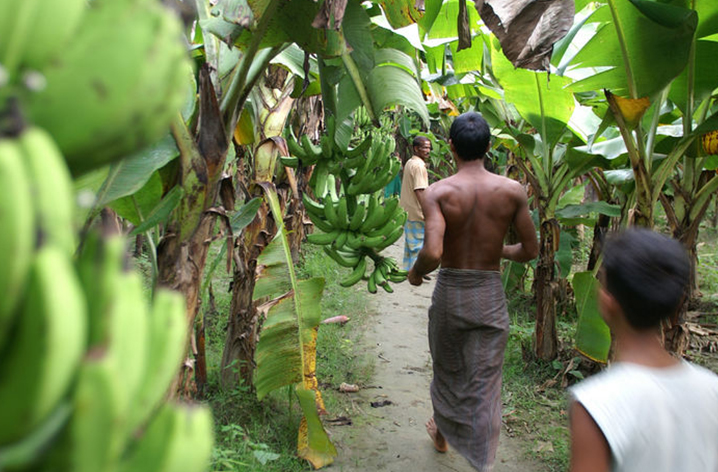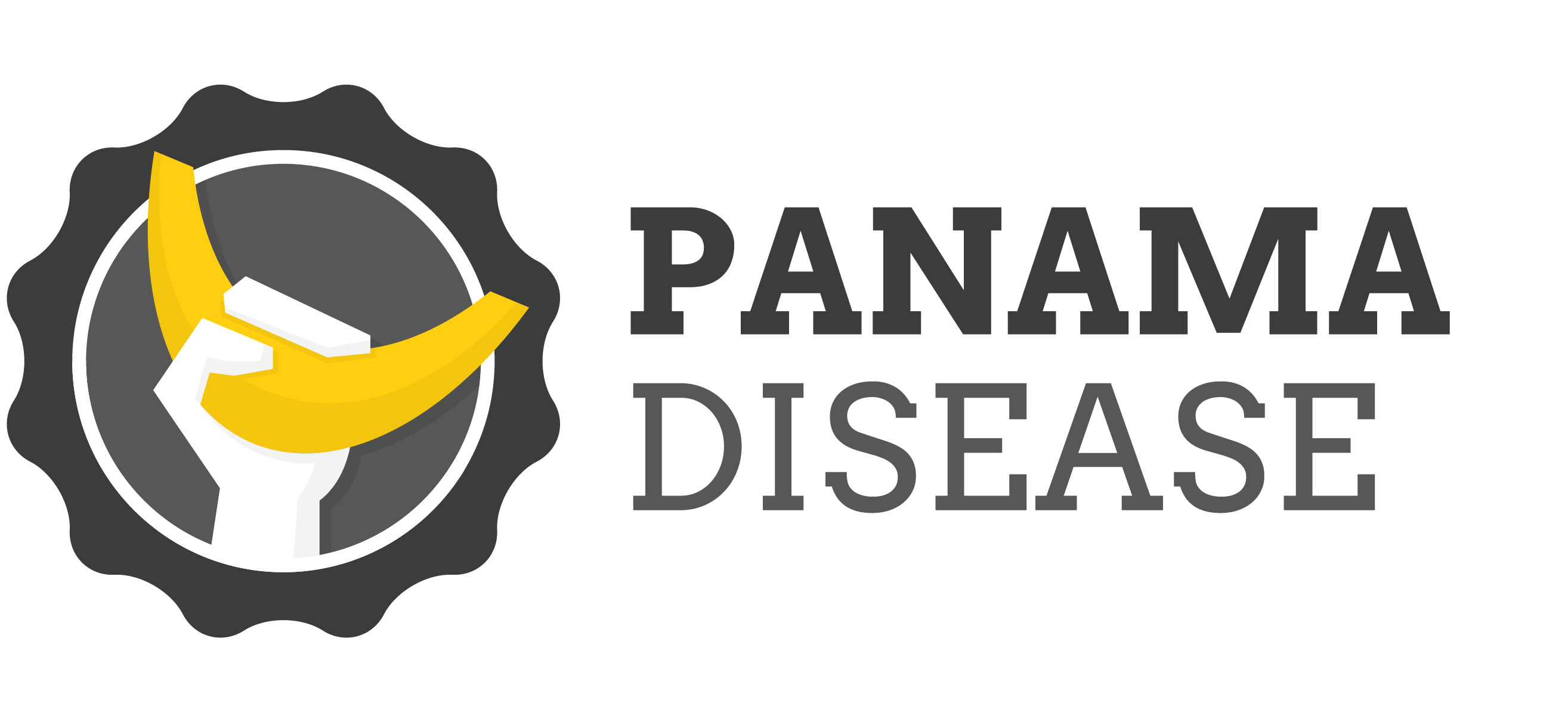
Jul 22, 2019 | Publications, Publicity
In Colombia four plantations in northern Colombia have been quarantined because of suspected infection with Fusarium wilt tropical race 4 (TR4). This finding has yet to be confirmed. As can been seen in Asia, the extreme damaging banana disease can wipe out entire plantations. “So, we should take this extremely seriously,” says Gert Kema, a plant pathologist at Wageningen University in the Netherlands.
Source: Science mag
Back to News page

Apr 2, 2019 | Publications, Studies
The first bananas were harvested in a Wageningen Greenhouse,
according to the Wageningen World Magazine. Researchers have been growing them
above ground in order to trying to outsmart the Panama disease caused by Fusarium Wilt, which is threatening the banana population
around the world.
From all sides researchers are looking for approaches, e.g.,
genetics and growing conditions, to making global cultivation more sustainable.
Check out this article in Wageningen World.
Back to News page

Mar 20, 2019 | Publications, Studies
New methods to efficiently monitor Panama disease, also known as Fusarium wilt, caused by Fusarium species in bananaswere developed during the PhD research of Fernando Garcia-Bastidas at Wageningen University and Research. These new methods and trials enabled a close monitoring of the international and intercontinental dissemination of the so-called Tropical Race 4 (TR4) strain of Fusarium odoratissimum, a new species originating from Indonesia that devastates banana plantations of Cavendish as well as many other local varieties around the world.
Fernando Garcia-Bastidas defended his
dissertation entitled ‘Panama disease in banana: Spread, screens and genes’ on
March 19, 2019 at Wageningen University. The thesis describes the developing
pandemic of a Fusarium species, which
causes Panama disease in banana. He focused his research on the genetic
diversity for resistance towards a panel of Fusarium strains representing
global pathogenic diversity and aspects of the molecular interaction between
the fungus and the host.
The thesis further explores the resistance
to TR4 in a wide panel of banana accessions and the possible use of a
resistance gene from a wild banana ancestor by genetically transforming Cavendish
bananas, thereby providing a potential solution for sustainable disease
management. Lasting disease management, however, relies on genetic diversity
and the research described in this thesis is the basis for developing such new
varieties.
For more information, see this page.
Back to News page
Nov 19, 2018 | Publications
In an article in the PLOS One journal researchers identified a gene and protein that is required for full virulence of the fungus that causes Furasium wilt in Cavendish banana. A mutant of the Fusarium oxysporum f.sp. cubense (Focub) SIX1a gene was tested in the banana plant. This mutant was found to be severely compromised in its virulence. When the gene was reintroduced virulence was restored to wild type levels.
More about the research in the PLOS One article ‘A SIX1 homolog in Fusarium oxysporum f.sp. cubense tropical race 4 contributes to virulence towards Cavendish banana.’
Back to News page
Nov 5, 2018 | Publications
Recent research on improving banana cultivation is bundled in the new publication ‘Achieving sustainable cultivation of bananas Volume 1’. Both the banana research community as well as banana producers will find information from all over the world about the current challenges in banana production, improving cultivation practice across the value chain, from propagation to harvesting, packaging and ripening, and ways of measuring and improving the environmental impact of banana cultivation.
Throughout the book attention is paid to pests and diseases affecting bananas, including Fusarium wilt. Highlights of the book include: the latest research on banana domestication and genetic diversity; new research on the limitations of current good agricultural practices and how areas such as soil health can be improved; and summaries of best practice in neglected but critical areas such as harvesting and ripening operations.
More information and the opportunity to order the book at the publishers website.
https://shop.bdspublishing.com/checkout/Store/bds/Detail/WorkGroup/3-190-55859
Back to News page
Jul 27, 2018 | Publications
The Biomedical Science Journal for Teens has put research into banana Black Sigatoka disease in the spotlight. The disease is threatening commercial Cavendish banana crops worldwide, as the fungus that causes it has developed resistance to the chemicals that are supposed to control them. Researchers also detected a specific protein in the fungus, that triggers the resistance mechanism of the plant. These yet unknown disease resistance genes could be used to save the banana industry.
In order to further support the sustainable production of bananas researchers wanted to find out more about the genetic basis of disease resistance to Pseudocercospora fijiensis strains, which cause the Black Sigatoka or “black leaf streak disease” (BLSD). Researchers isolated the DNA of the fungus, sequenced its whole genome and built a genetic map to complete the genome picture to better understand the relationship between the banana and its pathogen.
Also, they found a gene that is coding a protein, a so-called effector protein, which triggers a resistance mechanism in wild bananas. Upon recognition, the plant kills the infected cells and surrounding cells, thereby stopping the spread of the infection. Bananas recognizing this protein most likely possess a resistance gene. This could greatly help banana breeding and production.
Less bananas due to reduced photosynthesis
When bananas are affected by BLSD, the fungus destroys the leaf tissue which reduces photosynthesis and thus, crop yields. Farmers can control BLSD only through fungicides, and this greatly increases the economic and environmental costs to produce bananas. Moreover, the frequent use of fungicides leads to strains that are increasingly resistant to these chemicals.
Further reading
Read the whole article in Science Journal for Kids
http://www.sciencejournalforkids.org/uploads/5/4/2/8/54289603/fungus_genome_article.pdf
The article is based on the PLOS genetics article: ‘Combating a Global Threat to a Clonal Crop: Banana Black Sigatoka Pathogen Pseudocercospora fijiensis (Synonym Mycosphaerella fijiensis) Genomes Reveal Clues for Disease Control’ http://journals.plos.org/plosgenetics/article?id=10.1371/journal.pgen.1005876
Back to News page




Recent Comments